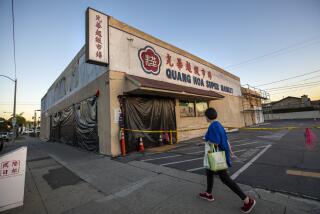An Onslaught of Settlers Eats Away at Tibetans’ Wealth and Way of Life : Migration: The Chinese have forced residents of the ancient mountain country to submerge their culture while Beijing strips away the once lush forests.
- Share via
Forty years ago the isolated valley east of Samarlu in eastern Tibet was covered with thick forest, interspersed with grazing yaks and stone villages. The village of Markham, a little Tibetan yak butter trading center, nestled between the steep valley sides on a rare piece of flat land.
In the early 1950s, the army of the newly founded People’s Republic of China surged west in its invasion of Tibet. The soldiers were followed by Chinese settlers.
Today in Markham, 40,000 people are crammed into seven-story apartment blocks wedged into that narrow valley scarcely more than 1,300 feet wide. It is the capital of what is officially called the Aba Tibetan-Qiang Autonomous Prefecture. Despite official claims, however, one is hard pressed to find more than a few thousand Tibetans, let alone Qiang (a minority group related to Tibetans) in this city with an unremittingly Chinese face.
New cities like Markham are springing up throughout this nominally Tibetan prefecture. They are increasingly attractive to Chinese settlers tired of old cities with few opportunities. In this isolated area it is possible to make money without many of the bureaucratic restraints in eastern China. Restaurants here boast an unusually wide range of vegetables; store shelves bulge with consumer goods; the streets are spotless and a prosperous, almost carnival atmosphere pervades the city.
Even more of an incentive to young settlers was the fact that until this year Chinese in Markham were permitted to bear two children in contrast to the stringent one-child policy in force throughout most of China. In other parts of the prefecture such as Ngaba town--called Aba by the Chinese--the more lenient policy still applies, undoubtedly a major reason for migration to an area that the Chinese would otherwise consider inhospitable and dangerous.
There are an increasing number of settlers like Wang, a 38-year-old party cadre, married with two teen-age children. He grew up in the area and is quite happy to live the rest of his life here. He believes strongly in the industrial development of the Aba Prefecture and links this to the progress of his country.
“The advancement of my country is very dear to me,” he said. “I have worked hard for it and if the standard of living does not improve and the economy does not develop it makes me very unhappy.”
It is true that the economic liberalizations of the last decade have enabled Tibetan farmers in this area to make good money selling barley, apples, wheat and vegetables on the open market. With their new-found surplus cash Tibetans are extending their old two-story stone houses into imposing buildings up to four stories high and 40 feet wide.
While some Tibetans are beginning to recover financially from the turmoil of the 1960s, they are nevertheless acutely aware of why the Chinese are so interested in this once sleepy backwater. “We sit here every day,” said Tenzin, a middle-aged farmer sitting with his family by the side of the road during their lunch break, “and we watch the logging trucks go by, down to Chengdu. I’ve watched it for years.”
The hills around Markham, richly covered with pine and spruce forests 30 years ago, are now barren. In the whole Min River valley, on which Markham stands, forest cover has dropped from 30% to 18% since the Chinese arrived in 1949. For several hundred miles the fast-flowing river is clogged with timber heading for Chengdu during the rainy season. Deforestation of the area has forced the government to move logging operations a further 50 miles west of the town, while heavily laden trucks continue to ply the Chengdu road all year round. Except for a few acres planted on easily accessible flat areas, there is little evidence of reforestation programs.
The Tibetans are losing the wealth of their land. Chinese in Markham admit that the city is prosperous because of the money brought by the timber industry. Through a strict system of logging licenses, the government retains control of the timber industry and therefore the profits.
“What can I do for the welfare of my people?” asked Sherab, a high school pupil, sitting in a teahouse just out of Markham. “In the time it takes me to drink one cup of tea I count an average of 15 trucks loaded with timber passing by. I see the wealth of our land being taken east every day and I do not think that it is right. We are getting nothing from it. What can I do to stop this happening?”
He continued: “At the few factories that are operating here, the workers are mainly Chinese. You have to be able to speak Chinese to work in these factories. We want our own factories.”
The government has plans to step up extraction of the area’s natural resources. An official November, 1989, publication that promotes the Aba Prefecture in an attempt to attract foreign investment foreshadows the exploitation of “dozens of main mineral products such as uranium, gold, iron, manganese, titanium, tin, tungsten, lead, zinc, coal, marble, diamond, spodumene quartz, etc. . . . Peat reserves up to 7 billion cubic meters rank first in the world. . . . There are 3.3 million hectares (8.25 million acres) of forest . . . in which grow more than 40 kinds of valuable trees.”
Unlike the town of Ngaba, there have been no nationalist demonstrations or illicit independence posters in Markham. Indeed, the area is so isolated that many Tibetans here are unaware that the Dalai Lama has been awarded the Nobel Peace Prize, despite the fact that it was reported in the Chinese media.
Nevertheless, like the outspoken Sherab, most Tibetans are loyal followers of their exiled leader and are suspicious of Chinese designs on their land. Forty years of twists and turns in Chinese politics, however, have taught them to remain circumspect.
When Tenzin, the middle-aged farmer, was asked about relations with the Chinese, he replied: “It is very good. What we eat, what we wear and everything else we buy--Thermoses, bicycles, even chopsticks--are all bought from the Chinese. Yes, our relationship is very good.” He laughed heartily and soon the infectious humor spread to his whole family. Only when he was pressed did he add, “If I said any more they would chop off one of my ears,” and he laughed even more.
Survival of the Tibetan culture in the Aba Prefecture is threatened by the impact of a Chinese urban culture on a rural environment totally unprepared for the onslaught. Tibetans by and large have avoided the new Chinese cities and find refuge in their homogeneous farming villages. The younger generation, however, go to Chinese schools and contemplate careers in the Chinese Establishment.
More to Read
Sign up for Essential California
The most important California stories and recommendations in your inbox every morning.
You may occasionally receive promotional content from the Los Angeles Times.













